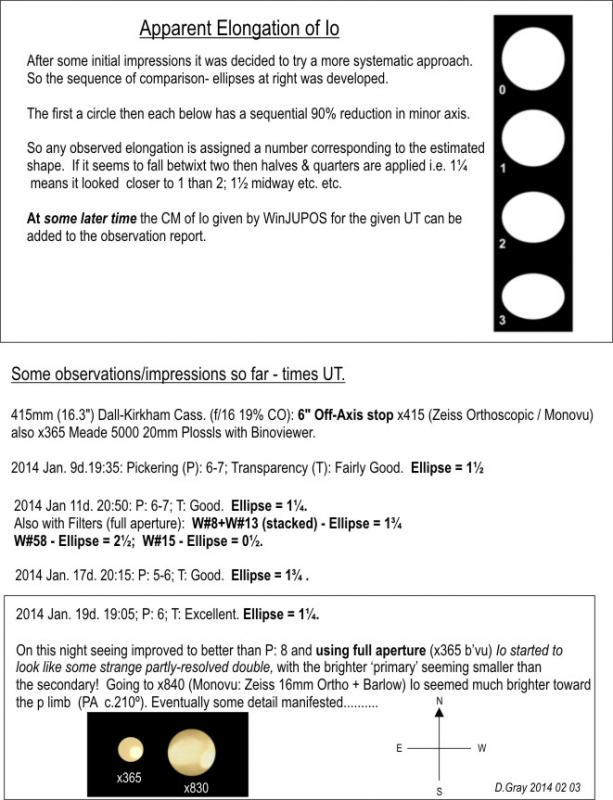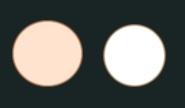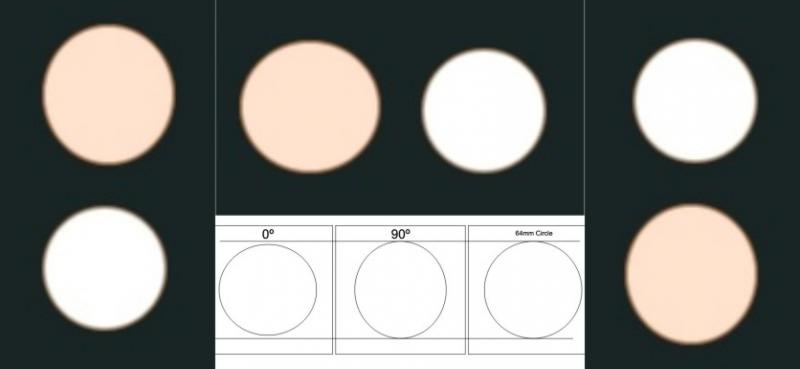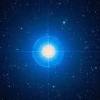
Some thoughts on a Transit of Io
#126

Posted 14 December 2012 - 07:18 AM
Pete
#127

Posted 07 May 2013 - 05:08 AM
Eddgie, maybe this will help your explanations. I'm a CAD operator in real life, and I used CAD to do a rough simulation of the diffraction effects involved in our observations of Io. I humbly submit it here for discussion. This models an 8" telescope with no CO, giving an Airy disc of 0.68". I've laid multiple airy discs over a grid laid on the face of "Io", with equatorial region discs shown bright, and polar discs shown darker.
It's a good likeness to what I observed, allowing for my crude simulation.
J
Hi Jason,
Reading through this in another link led me to question the diagram
you attached. While I agree with the diagram in principle as to how diffraction defines a small orb like Io through an 8" scope it would seem its also exaggerated heavily. The image of Io would infact bloat like that beyond its physical apparent size if it had the surface brightness to fill it out like that. This diagram works better when the target is a star for example where its surface brightness is exceedingly high . Then if you had a point source like a star now filling in the size of IOS apparent size with all those infinite points it'd be dazzling. Infact it'd be so bright you wouldn't want to look at it and if you did it would indeed be bloated glaring and soft edged.
Such as it is those per infinite point Io is far dimmer and doesn't swell as you've shown.
The diagram does show how the ovular shape is affected by diffraction and the lesser surface brightness on the poles but its misleading to . I'm convinced at Ios brightness level there is no swelling visible beyond its observed physical size.
Pete
#128

Posted 07 May 2013 - 12:38 PM
Now, at Io's angular diameter near opposition, it's well over 1/4 the Airy disc diameter. It is, indeed, an extended object with an enlarged PSF. But, how it behaves is very complicated.
I'd have to review Vlad's site, again, to speak to the question. But it does seem it acts as a series of point sources (1/4 x Airy diameter), some of which are brighter than others. After all, it's "football" shape does show very well in images for a reason (contrast and diffraction, I'd imagine.)
I'd like to know more, too.
In fact, I was just reading Sidgwick, he mentioned the apparent elliptical appearance of Jupiter I (Io) and 4 (Callisto.) Not sure what that's all about...LOL. Let me find and reread his statement.
Edit: found it. Sidwick's Amateur Atronomer's handbook, section 26.10, Scales of Seeing, subparagraph (b), page 465. He describes one of Pickering's seeing scales, the "eliptical outline of Jupiter I and IV" that disappears in large enough telescopes. Remember, he urged amateurs to observe Io with a 5" glass, so that is probably the aperture range this seeing scale is intended.
Jupiter IV is Callisto! Who's game? LOL
#129

Posted 07 May 2013 - 08:53 PM
I'm still undecided on the Io - is it the real limb or diffraction. I mean what if the poles are just merely too close to the background sky glare to show it seperated and whole disc? I'm straddling diffraction and contrast here with question marks. I know they are intertwined but still .
Pete
#130

Posted 07 May 2013 - 10:20 PM
You may be right about fervor and seeing Io as an elliptical orb. Still, I do believe I observed it. Of course, it is not obvious. It is difficult. It did require stable seeing and maybe it even required fervor to undertake such a difficult observation. So, fervor might have been an attribute, not something creating an illusion. It really helped to have Europa in the FOV for comparison. High power was a big help, too. But, sure enough...with patients and fervor (lol) it can be done.
Now, how and why are still a bit of a mystery. I believe it is diffraction effects, as Eddgie says. Io is small enough, still, to be dominated by it. Ganymede, in my 6" scope, is right about the angular dimension where it begins to become a true extended source. It's PSF is greatly expanded at opposition.
I'd have to review Vlad's take on this point source and extended object boundary. It's complicated, but that doesn't mean Io's elongation is any less real.
#131

Posted 08 May 2013 - 06:45 AM
Pete
#132

Posted 08 May 2013 - 07:27 AM
Also, my "simulation" is extremely crude. I'm sure it falls short on many levels.... My understanding of diffraction is limited.
J
#133

Posted 08 May 2013 - 02:59 PM
#134

Posted 14 May 2013 - 04:05 PM
#135

Posted 14 May 2013 - 09:28 PM
Pete
#136

Posted 15 May 2013 - 07:17 AM
I've not seen the effect with Io not in transit, though Pete (and doubtless others) has, and for that case, having a round reference (Europa) in view really helps with the comparison.
Good luck!
J
#137

Posted 02 February 2014 - 02:55 PM
David Knisley posted the following . Because he commented as well the lunar forum was not the place for this topic Ive transplanted it here. Here's what David had to say:
Over the past 46+ years since my first view of Io way back in 1967 in my first telescope (3" f/10 Newtonian), it has never appeared as anything other than a dot or a small disk. It never appears out of round, and even in my 14 inch, it just shows its pale dirty yellowish disk. The only time I ever got to see any major detail on that disk was during the Nebraska Star Party using a 30 inch Newtonian at over 500x. Even then there wasn't a lot of detail to see. The polar regions were only very slightly darker (and *not* uniformly so) than the rest of the moon's disk with rather low contrast. Sorry, but elongation of that moon just hasn't been in the cards for me (and Pickering's observations are not worth commenting on, as they clearly represent something other than a true level of detail or resolution). Imaging to support "elongation" also has some problems, as the transiting Io will tend to have adjacent linear detail change the shape of the dot of Io in a way that is not necessarily matched visually. Again, the resolution of the disks of the moons of Jupiter and any detail they might show would be best done on a different forum. Clear skies to you.
--------------------
David W. Knisely . . . . . . "If you aren't having fun in this hobby, you aren't doing it right."
Hi David,
Just to be clear Im not suggesting Ive seen dark poles on Io or anything on Io infact and up until I made a concerted effort a year ago or more Id never noticed this moon as anything but a round 1" dot. In inspecting it at over 300x with the information put fourth in this thread I gave a look see. At first it was just well, a golden warm toned dot indeed. Studying it though it was conceivable how it could be seen to appear somewhat full around the belt line, ie; equator. It was one of those hmmm moments. What clinched it was Europa just next to it and granted the sizes are slightly different but the circularity of Europa gave away this subtle oblate nature of Io that had been discussed. Had Europa been behind Jupiter I may have said " undecided but suspicious of oblate nature" or something to that effect . Io appeared rotund - a strange word for a round body but that was the knee jerk impression. Its fullness was the effect of its brighter middle averaged out with its darker poles as ever so slightly ovular. The face of Io was blank as always - its profile was in question here. By contrast it never showed the hard perfect roundness of Europa.
I don't doubt on 46 years its never been but a dot and had I not tried on a decent night it'd be another 46 for me (actually 30).
The experience you have had with some very large aperture wouldn't be revealing here because the oblate profile is a diffraction effect of medium aperture. At 14" Ed Moreno had agreed the disc would appear round and not oblate because by that point the angular resolution and contrast would be sufficient to reveal Ios truer spherical nature. If anything David something like a 6" off axis mask would be revealing than large aperture because you'd be introducing the lower resolution diffraction effects responsible here. Timo as well as Sheehan, Pickering, Barnard all have realized greater aperture does not show the ovular profile but it was never a physical attribute of Io to begin with.
I would say this - if you get a night of 6-7 Pickering and stop down your scope to 6" , use at least 250x and time it with a close grouping if Io and Europa and Im certain you'll see the effect. The moon will be forever blank but its profile will appear, again, slightly rotund. A low res diffraction effect.
I appreciate you as a very careful, informed and responsible observer but I KNOW you'd see it under the suggested conditions. This is a call that needs a "control" close by to make a confident call.
Pete
#138

Posted 03 February 2014 - 07:40 AM
In the first place I do not think I/we are getting anything more than indications of real features on these bodies with our ‘backyard’ scopes. For myself I am not trying to supersede NASA mapping
In actuality I have done less than a dozen drawings showing detail on those moons – not counting in-transit efforts since my first attempt in 1965. None of the former have I ever submitted to the BAA Jupiter Section to which I have contributed since 1969 when W.E. Fox was in charge. I have seen/suspected such detail on many nights: 1964-78 10” f/8 Newtonian and ’78-on with the 16.3” D-K but only very occasionally do I go for a drawing. In particular I find some Ganymede-features quite contrasty with x365 and that can lure me to check out the form of these with more magnification.
John Rogers makes no bones about his position on such drawings; though he is more acceptant of views of transits and such. In fact on page 326 of his book “The Giant Planet Jupiter” he shows a number of Io transit views including one I got in 1989. An SEB fade was in progress at the time and offered an ideal light, near-featureless, backdrop which allowed me to get darker poles and a duskier f. side of the satellite.
I have to confess I never really checked for any elongation with Io until I saw mention by Norme & Pete. What I report here does not contradict their impressions at all. But I further got the impression that the major axis of the apparent ellipse does not always line up with the angle of Jupiter’s belts being (so far) seen to vary as much as perhaps +/-20º. This subject to further good views of course. In keeping with their practice the other satellites are checked for any out-of-roundness. No astigmatism was apparent with myself or the optics – easily checked by rotating the viewing angle or the eyepieces.
Norme is aware of some of my above-mentioned efforts as I show with this PM I sent him on Jan. 14.
Sent to: Asbytec
Hi Norme,
I’ve been caught up with more ‘90s Saturn reporting – 86 dates this time so have stepped back somewhat from CN as I don’t want to look as though I’m ignoring folks…! So herewith a PM that I resisted putting on your thread.
Had a look at Io on Jan 9 (19:25-50 UT) & Jan 11 (20:45-21:40) and I am very assured of the elongated aspect on both dates. Certainly with a 6” off-axis on the D-K (x365 - binovu & x415-monovu). Not only that but also with the full 16.3” when the image is dimmed suitably – apodizer, filters and/or thin cloud. Further I find that the elongation major axis on these dates is not in line with the Jovian belts but slanted some 20º say toward p.a. 110º-290º: consistently – other moons looked quite round.
Further to that I find it is more marked in green filters than any other which suggests that the reddish polar caps are indeed the culprit.
I really need better seeing to follow-up however as on these dates with more ‘normal’ seeing. I find it a little peculiar in that I’m getting Pickering 6-7 with my focus-check- double Eta Gem (BU 1008); and the moons themselves come to that – but Jovian features relatively ill-contrasted for Antoniadi III/II-III!!
Maybe a project here into following apparitions and perhaps use such as WinJupos to plot against Io-CM when enough observations to hand…..
Also got a light polar region with Ganymede on the 11th with both apertures.
Dave.
#139

Posted 03 February 2014 - 08:28 AM
David,
Thanks for the account and kudos to Norme for keeping this under wraps!!
Its interesting that you see the brighter equatorial region offset at an angle differing from jupiters belts and to that end - well that's high res for you. Interestingly I never considered using filters - but at 8" while I can see ios color Id wonder if it'd stand up to a 58 green I have. A curious thing is I actually saw an image in one if the links that was in the Plato thread that does infact show the offcenter limb brightness of Io - both as it sits with Jupiter as a back drop but to a decidedly lower res image after it regains the backdrop of dark space.
Any chance you can qoute Rogers feelings on submitting drawings of the moons? I'm guessing his feelings are its too wrought with poor seeing effects and such and tough to do reliably.
I've got to get the book. Nice post David and thanks for weighing in.
Pete
#140

Posted 03 February 2014 - 09:47 AM
Yea, this is not ground breaking science to dispute NASA, it's just an observation other amateurs can enjoy. Add one more Jovian moon to the list of exciting moons. Something to extend common knowledge in the amateur community, a challenging observation for us to get excited about and check off.
Long ago, Pete pushed me toward Ganymede. I thought there was no way, can't be done. Too small, diffraction resolution, etc. Turns out, it can be done...that was exciting. Its observations like this that keep it interesting.
#141

Posted 03 February 2014 - 10:58 AM
I hope to develop further on these issues shortly!
In the meantime I have a very good view of M82 & SN from last night to get on the PC for Sketching Forum. But a vile stiff-neck/headache at the moment.
Fun. Fun. Fun!
Dave.
#142

Posted 03 February 2014 - 10:13 PM
Guys here's a sketch I made from the best night I had in seeing Ios diffraction effect through my 8" - 364x and Pickering 6 seeing and some patience in December 2012. Io on the left and the control being nearby Europa on the right - though much farther apart in real life of course. Naturally for me the face is bald but ever that diffraction swell across the equator.
Pete
#143

Posted 03 February 2014 - 11:25 PM
First that's about the apparent and difficult elongation I observe - just barely non round. That David can quantify and determine an apparent position angle it is nothing short of astounding. Such might be beyond me, but I didn't think to try. It was all I could do to see apparent elongation.
Second that you (and David) did it in Pickering 6 means so many others should be able to re-Pete (LOL) your observation. I managed it in Pickering 8 and that means I am just normal, I guess, not a super human observing machine, after all.
Now, Imagine the scene with both Ganymede with it's surface albedo and Io with it's elongation in the same FOV. I had that view a few weeks ago, it was simply beautiful.
#144

Posted 04 February 2014 - 08:08 AM
Pete
#145

Posted 05 February 2014 - 07:09 AM
Firstly to address Pete’s fine graphic of Io v Europa roundness. Much as I find, the apparent ellipse hovers close to the profile of Saturn’s globe which turns out to be ellipse #1 in my comparison graphic.
I think a further test is to put the line of the eyes at 90º to the initial ‘horizontal’ sighting which should exaggerate the major axis relative to minor. This, assuming it is a common illusion as I detailed to Norme in his Ganymede and Io thread.
http://www.cloudynig...6297950/page...
“Perhaps the elongation is greater than thought? If I recall/understand right our visual system causes us to see vertical dimensions taller than they really are. Looking at a Jupiter ellipse (BAA 64x60mm) or Jupiter itself and turning it 90º demonstrates this markedly - to me at least.
Similarly with Uranus' near n/s equatorial aspect this still causes me to see it as quite oblate - as the increasing tilt is now starting to equalize(circularize) polar & equatorial axes.
The 'Jupiter' graphic hopefully demonstrates - tho' individual monitor's aspect ratios might come into play.......!”
I have taken the liberty to use Pete’s graphic to further demonstrate with the attached.
Of course if this illusion is universally apparent; then using a true circle (Europa) works for us as the vertical axis exaggeration effect then gives added contrast with the compared object’s X-axis. Assuming most of us get this illusion, a monitor that has perfectly adjusted aspect ratio should show a circle as having a greater Y-axis. Actually I initially found that effect quite troublesome/irritating when first using such as Corel Draw – my perfect circles always looking a little ‘horizontally-challenged’. The way around it was to hold some object of known true/measured circularity against the screen as a check – more troublesome in the CRT days!
As I already indicated it is to my discredit that I failed to ever notice Io-elongated as Pete & Norme have done. Perhaps it is where my approach to observing went against me: where I endeavor to look on an object rather that at it – failed to see the form of the tree whilst seeking scrutiny of the leaves!
Dave.
#146

Posted 05 February 2014 - 02:35 PM
This'd be such a difficult affair if Io was jupiters lone moon.
I had no idea that the illusion of the flipped ellipse was so striking. I never knew the phenomenon even existed. Thanks your reply and illustrations.
Pete
#147

Posted 05 February 2014 - 04:06 PM
I too have never used tracking; the mount is fitted for it but never got round to getting it to work right. In fact I feel that letting the object drift across the field discourages fixated staring. Since getting the Meade 5000 Plossls I find I have an excellent virtually undistorted AFOV of 60º, ideal for drift-across views! But even with the lesser fields of my excellent Zeiss 16mm & 10mm Orthos. I find no hardship even when Barlowed to over x1000. Also the 28º of the Monocentric at x485 is manageable - the hefty rock-steady well aligned mounting being crucial here!
I know what you mean about Jupiter coming in at steep angles. The Amici (erecting) prism does that with single eyepiece views but not with the binoviewer which pretty much shows how it is in the sky no matter where the Amici is rotated to; in my experience at least.
Dave
#148

Posted 05 February 2014 - 11:26 PM
#149

Posted 06 February 2014 - 07:00 AM
I always liked, to me, the aesthetically-dynamic look of Jupiter when highly inclined in the field of view. Part of that being the more evident presentation of it’s oblate figure. There is a further advantage, to some at least, in that when it is more perpendicular to the eye-line it can make very faint belts more certain. Nothing to do with the vertical-effect/illusion as far as I know. It was something old-time observers used to use as a check; tho’ some found no gain. It certainly works with me to a good degree; but using the binoviewer a lot now I do not get to apply it so much – always a trade off!
As I said previously I have some things re. the Jovians etc. that I may post, but possibly somewhat off-topic here. Not sure if to go to your recent “Extended Object Resolution” or start a new thread. Anyone who has Peek’s “The Planet Jupiter” (1958) and looks at chapter 32 might get a hint from where I’m coming.
When next apparition kicks off we have again the opportunity to observe mutual satellite phenomena. Peek’s book has some things to say regarding the visibility of, in particular, Europa’s shadow on Io & Ganymede and goes on to ‘prove’ that failure to see these stark black spots in amateur scopes is pretty damning against albedo drawings with these. I recently investigated his reported dates of Phillips and others impressions with WinJUPOS and get the impression that Peek greatly underestimates the darkness of the penumbra thus rendering the black umbra/spot very much less contrasty. Not that I take WinJUPOS simulations that literally without further inquiry; but clues are there!
Having said all that maybe another thread is in order
Cheers,
Dave.
#150

Posted 06 February 2014 - 08:21 AM
I wish I had the Peek book though.
Pete
























